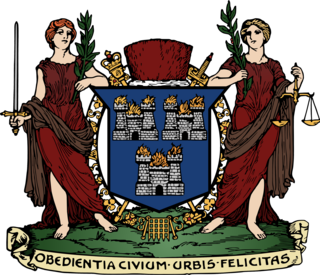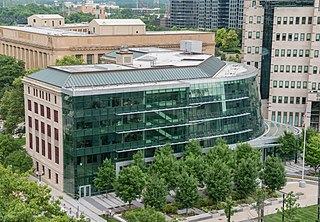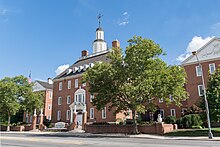
Doral is a city in Miami-Dade County, Florida, United States. One of 34 municipalities in the county, it is located 5 miles (8 km) west of Miami International Airport and 13 miles (21 km) west of Downtown Miami. Doral occupies 15 square miles (39 km2) bordered on the west by the Ronald Reagan Turnpike and the Florida Everglades, on the north by the town of Medley, on the east by the Palmetto Expressway and on the south by the Dolphin Expressway and the city of Sweetwater. The city is part of the Miami metropolitan area of South Florida. As of the 2020 census, Doral had a population of 75,874, up from 45,704 in 2010.

Dublin City Council is the local authority of the city of Dublin in Ireland. As a city council, it is governed by the Local Government Act 2001. Until 2001, the authority was known as Dublin Corporation. The council is responsible for public housing and community, roads and transportation, urban planning and development, amenity and culture and environment. The council has 63 elected members and is the largest local council in Ireland. Elections are held every five years and are by single transferable vote. The head of the council has the honorific title of Lord Mayor. The city administration is headed by a chief executive, Richard Shakespeare. The council meets at City Hall, Dublin.

The mayor of Honolulu is the chief executive officer of the City and County of Honolulu. An office established in 1900 and modified in 1907, the mayor of Honolulu is elected by universal suffrage of residents of Honolulu to no more than two four-year terms. The City and County of Honolulu's elected officials include the mayor, the prosecuting attorney, and councilmembers representing nine districts.

Michael B. Coleman is an American politician of the Democratic Party who served as the 52nd mayor of Columbus, Ohio. He was the first African-American to serve as the mayor of Ohio's capital city.

The Seattle City Council is the legislative body of the city of Seattle, Washington. The Council consists of nine members serving four-year terms, seven of which are elected by electoral districts and two of which are elected in citywide at-large positions; all elections are non-partisan. It has the sole responsibility of approving the city's budget, and develops laws and policies intended to promote the health and safety of Seattle's residents. The Council passes all legislation related to the city's police, firefighting, parks, libraries, and electricity, water supply, solid waste, and drainage utilities. (The mayor of Seattle is not considered part of council.)
The Government of Denver makes up the public sector of the City and County of Denver, Colorado.

The City of Tulsa has a mayor-council form of government. This form of government has been in place since 1989, at which time Tulsa converted from a city commission form of government. The mayor is elected by the entire population and each of the 9 Councilors are elected from districts based on population.

The Columbus Division of Police (CPD) is the primary law enforcement agency for the city of Columbus, Ohio, in the United States. It is the largest police department in Ohio, and among the twenty-five largest in the United States. It is composed of twenty precincts and numerous other investigative and support units. Chief Elaine Bryant assumed leadership of the Division in 2021. Special units of the Columbus Division of Police include a Helicopter Unit, Canine Unit, Mounted Unit, Community Response Teams, Marine Park Unit, and Special Weapons and Tactics Team (SWAT).

The Sacramento City Council is the governing body of the city of Sacramento, California. The council holds regular meetings at Sacramento City Hall on Tuesdays at 6:00 pm, with exceptions for holidays and other special cases.

The Government of Indianapolis—officially the Consolidated City of Indianapolis and Marion County—is a strong-mayor form of mayor-council government system. Local government is headquartered downtown at the City-County Building.

Honolulu County, officially known as the City and County of Honolulu, is a consolidated city-county in the U.S. state of Hawaii. The city-county includes both Urban Honolulu and the rest of the neighborhoods on the island of Oʻahu, as well as several minor outlying islands, including all of the Northwestern Hawaiian Islands except Midway Atoll.

The government of the City of Los Angeles operates as a charter city under the charter of the City of Los Angeles. The elected government is composed of the Los Angeles City Council with 15 city council districts and the mayor of Los Angeles, which operate under a mayor–council government, as well as several other elective offices. Under the California Constitution, all judicial, school, county, and city offices, including those of chartered cities, are nonpartisan. The current mayor is Karen Bass, the current city attorney is Hydee Feldstein Soto and the current city controller is Kenneth Mejia.

Cleveland City Hall is the seat of government for the City of Cleveland, Ohio, and the home of Cleveland City Council and the office of the Mayor of Cleveland. It opened in 1916 and is located at 601 Lakeside Avenue in the Civic Center area of Downtown Cleveland. The building was the first of its kind designed by Cleveland architect J. Milton Dyer for governmental purposes for a major U.S. city. At the time of its construction, City Hall was to continue the city planning of Daniel Burnham's 1903 Group Plan. City Hall stands as a historic landmark that was added to the Cleveland Landmarks Commission.

Columbus City Hall is the city hall of Columbus, Ohio, in the city's downtown Civic Center. It contains the offices of the city's mayor, auditor, and treasurer, and the offices and chambers of Columbus City Council.

The Columbus Civic Center is a civic center, a collection of government buildings, museums, and open park space in Downtown Columbus, Ohio. The site is located along the Scioto Mile recreation area and historically was directly on the banks of the Scioto River.

The George Floyd protests were a series of protests and civil disturbances that initially started in the Minneapolis–Saint Paul metropolitan area of Minnesota, United States, before spreading nationwide. In Columbus, Ohio, unrest began on May 28, 2020, two days after incidents began in Minneapolis. The events were a reaction to the murder of George Floyd by Minneapolis Police Department (MPD) officer Derek Chauvin, who knelt on Floyd's neck for over nine minutes, asphyxiating him.

The Michael B. Coleman Government Center is a municipal office building of Columbus, Ohio, in the city's downtown Civic Center. The building, completed in 2018, is named for former mayor Michael Coleman.

77 North Front Street is a municipal office building of Columbus, Ohio, in the city's downtown Civic Center. The building, originally built as the Central Police Station in 1930, operated in that function until 1991. After about two decades of vacancy, the structure was renovated for city agency use in 2011.

The Columbus Division of Police Headquarters is the central office of the Columbus Division of Police, of Columbus, Ohio. The building is located in the city's downtown Civic Center. It is the fifth headquarters for the Columbus police department. The eight-story building was designed by Brubaker/Brandt in the postmodern style, and reflects elements of City Hall's design.

The Columbus City Prison was a municipal prison in Downtown Columbus, Ohio. The building was constructed in 1879 in a castle-like style, designed by architect George H. Maetzel. The building served as a prison and headquarters of the Columbus Police Department until a fire demolished the structure in 1920.























